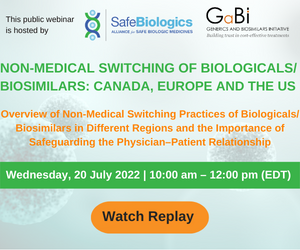Post-translational modifications (PTMs), particularly glycosylation, will play a critical role in how biosimilars – also called follow-on biologics or biogenerics – and will eventually be approved in the US. This stated science writer Mr Angelo DePalma in Genetic Engineering & Biotechnology News of 1 February 2009.
As he pointed out, the US Food and Drug Act, under which small molecule drugs are approved, does not apply to biologicals. Neither does the Hatch-Waxman act of 1984, which created the generic drug industry (although earlier generic bio-drugs like insulin and human growth hormone were grandfathered under the drug law).
Potential developers of biosimilars lack a roadmap for comparing their product to the originals. In the US this still means that they must subject their product to full preclinical and clinical testing before it can be approved by the FDA. Since innovator companies are not obliged to share information with potential competitors, the latter are left to their own devices in designing processes that will faithfully mimic blockbuster biologicals. But in biotech the product is the process, especially in PTMs.
Since the inventors of a protein drug are not obliged to disclose their processes, potential developers of biosimilars must invent a new manufacturing method of their own and hope its end result is a protein that behaves similarly to the original. Potential biosimilar manufacturers hope to prove their products exhibit sufficient structure and function similarity to the original protein through various analytical methods. Their goal is to convince regulators that extensive preclinical and clinical trials will not be needed to prove safety and efficacy. Which analytical methods and approaches will be most effective and reliable remains an open question.
At the ‘Follow-on Biologics Workshop: Scientific Issues in Assessing the Similarity of Follow-on Protein Products’ held on 12-14 December 2005, New York, USA, it was concluded that protein structure cannot be solved by a single method and needs multiple, orthogonal analytical techniques. Comparisons between biosimilars and originator molecules are complicated by the diversity of protein structure, including higher-order folding and associations plus PTMs.
PTMs are chemical transformations that occur after a protein’s translation from RNA and include numerous changes, some well known and others quite obscure. Modifications based on the addition of molecules or functional groups are the most apparent and probably the most significant in terms of biological activity. These include acylation/deacylation, amidation, methylation, phosphorylation, sulfation, oxidation, and even PEGylation (the synthetic addition of polyethylene glycol residues).
The best-known PTM is glycosylation, the addition of sugar residues to amino acids bearing amino or hydroxyl groups. Sugar moieties can be short (a few hundred Daltons), or longer and more branched (up to several thousand Daltons). Although sugars are ubiquitous in biological systems, analysing and generally working with these essential building blocks is difficult. Organic chemists learn to dread sugars for the dizzying diversity of individual residues, and particularly for their limitless combinatorial possibilities.
Glycan analysis occurs after cleaving sugars with an endoglycosidase, which leaves a pool of carbohydrates of various sizes and compositions for offline analysis. Alternately, one can use trypsin to cleave peptide bonds and generate smaller peptides or individual amino acids, and analyse them with the sugars in place by liquid chromatography-mass spectrometry (LC/MS). N-linked glycans also tend to follow rules of construction. It is possible to piece together their structures based on those rules and their fragmentation patterns in a mass spectrometer. Verne Reinhold at the University of New Hampshire pioneered these techniques and coined the term ‘glycome’ to define the sugar makeup of an organism or family of proteins.
Bluestream Laboratories specialises in analysing biopharmaceuticals, including proteins and antibodies glycosylated at multiple sites. The vast majority are N-glycosylations. Predicting where these will occur is relatively straightforward. The question is whether the site is actually occupied by a glycan. Serine and threonine glycosylations, which occur on oxygen, are more difficult to predict.
Even within a well-defined biological product, one sees significant heterogeneity in the glycome of a protein drug, not only from glycosylation site to site, but also among identical locations. Glycan analysis takes a few days for a well-characterised antibody to several weeks for a new molecule or fusion protein.
Sponsors of new protein drugs should learn all they can about glycosylation as early in development as possible, since regulators will be interested in glycan type, degree, location, and degree of sialylation. Glycosylation often controls a molecule’s activity, immunogenicity, and, in the case of sialic acid, its pharmacokinetics. Because a range of process conditions affect glycosylation, regulators look to patterns as an indicator of batch-to-batch consistency. It’s virtually impossible to make a protein with the same glycosylation patterns in two different processes. Even cell culture conditions can change them. One striking example is pure red cell aplasia, a rare, serious immune reaction to erythropoietin believed to arise from reactions to ‘unfriendly’ glycosylation and/or sialylation patterns.
Most experts agree that the impact of process on PTMs, and the potential of modifications to affect efficacy and safety, demands precisely the level of scrutiny that biosimilars are experiencing today from US regulators. There are simply too many unknowns to act otherwise. Diligent oversight will eventually lead to a regulatory pathway for biosimilars that considers products on a case-by-case basis.
Demonstrating what the differences are, quantifying them, and correlating them to clinical (safety or efficacy) outcomes will help the approval process. Developers need to show which PTM differences are trivial before arguing which clinical development steps can safely be skipped. It’s almost certain that any shortcuts will need to be justified empirically, in animal models and human subjects. Presumably, for certain products, some early human testing might be avoided, and perhaps some of the late-stage testing as well, but nobody will be able to predict, because nobody knows for sure.
Source: The New York Academy of Sciences, Genetic Engineering & Biotechnology News. Feb 1 2009;29(3).








 0
0









Post your comment